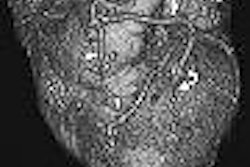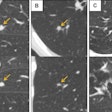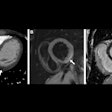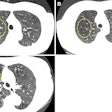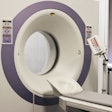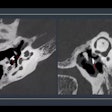Is it polyp or stool? The question is key in virtual colonoscopy, whose providers rely on a number of techniques to answer it. One way is to turn the patient over for half of the CT exam; prone and supine imaging has long been the standard of care. Lesions that move aren't really lesions and can be ignored, the thinking goes.
But a new study in this month's Radiology suggests that polyps, especially when long or pedunculated, can be mobile too, mimicking stool. The researchers, from New York University Medical Center in New York City, looked at the question and found that it actually happens pretty often.
"We have noted...that there are several limitations to the use of mobility as a criterion for differentiation of polyps and fecal material," wrote Shaked Laks, Dr. Michael Macari, and Dr. Edmund Bini. "Some colorectal polyps are detected with only one view because of inadequate distension or the presence of residual fecal material in certain colonic segments. Occasionally, fecal material can be adherent to the colon wall and does not move. Finally, lesions that appear to be mobile may be polyps." (Radiology, June 2004, Vol. 231:3, pp. 761-766)
The retrospective study examined data from 113 patients who underwent same-day virtual colonoscopy followed by conventional colonoscopy. Bowel preparation began a day earlier, with each patient ingesting two doses of phospho-soda laxative or four liters of polyethylene glycol. A rubber-tipped catheter was used to insufflate the colon manually with room air to patient tolerance, and several additional puffs of air were added between the prone and supine image acquisition.
If a scout image showed adequate insufflation, CT images were acquired using a 4 x 1-mm detector configuration, 120 kVp, 0.5-second gantry rotation, 50 mAs (effective) and beam pitch that varied from 1.5 to 1.8 to enable coverage of the entire colon in a single breathhold. CT images were reconstructed as 1.25-mm-thick sections with 1-mm reconstruction intervals, and were interpreted using a Vitrea 2 workstation (Vital Images, Plymouth, MN), the study team said.
Il polipo è mobile
All polyps 5 mm and larger were analyzed on the workstation, and the images were evaluated to determine if the polyp was present on both supine and prone datasets, or only one, and all such polyps were classified as pedunculated or sessile.
"Positional changes were defined as movement of the polyp from the dorsal to the ventral wall of the colonic lumen (with gravity) or from the ventral to the dorsal wall of the colonic lumen (against gravity) when the patient was moved from supine to prone position and vice versa," the authors wrote.
According to the results, 49 polyps 5 mm and larger were found in 49/113 patients. Eight of the 49 polyps were seen in only one view, prone or supine, due to poor distension (n=5), residual fecal material (n=2), or indeterminate causes (n=1).
Thirty of the 41 polyps (73%) seen in both datasets did not move relative to the colonic surface, however, 11/41 (27%) seen in both datasets did change their relative location when the patient was moved from prone to supine position. Nine polyps moved with gravity, and two polyps moved against gravity from the ventral to the dorsal surface of the colonic lumen, Laks and colleagues reported.
"Of the 11 polyps that changed position, five were pedunculated on a stalk. The mean size of these polyps was 17.2 mm (range, 11-27 mm)," they wrote. "Three of these lesions were located in the sigmoid colon, and two were located in the descending colon. In all five cases, movement of the patient from the supine to the prone position resulted in repositioning of the head of the polyp to the dependent surface of the colon."
The other six lesions were sessile (mean size 17.7 mm, range 6-40 mm), including two in the sigmoid colon, two in the transverse colon (15 mm and 40 mm, respectively) one in the cecum, and one in the ascending colon.
"There are a number of techniques and observations that facilitate differentiation of residual fecal material from colorectal polyps," the group wrote. "If a lesion has heterogeneous internal attenuation characteristics, such as areas of gas or high attenuation, the lesion most likely represents residual fecal material. The use of multiple window and level settings…facilitates recognition of these attenuation differences. If a lesion has homogeneous attenuation, examining it with three-dimensional endoluminal imaging is helpful in determining the morphology. Lesions that are round, oval or lobular may be polyps or residual fecal material; however, lesions that have angled geometric borders are consistent with residual fecal material."
Still, radiologists must be cautious when using lesion mobility as a sign of fecal material. At least one large study had a case in which a large pedunculated polyp was misinterpreted as fecal material secondary to apparent mobility, the authors wrote. When the morphology of a lesion is difficult to interpret, the use of coronal and sagittal multiplanar reformatted images, endoluminal views and transverse images, as well as thin-section imaging, are often helpful in nailing down the diagnosis.
Five of six mobile sessile polyps were located in the peritoneal cavity; two in the sigmoid colon. "The ability of the sigmoid colon to twist within the peritoneal cavity is further demonstrated by the fact that it is the segment of the colon in which volvulus most frequently occurs," they wrote. "Pedunculated polyps and sessile polyps in segments of the colon that are mobile may mimic stool by moving to the dependent surface when patients are repositioned." No sessile lesion changed position in the descending colon or rectum, they wrote.
"However, we have demonstrated a potential pitfall of imaging patients in the supine and prone position in the characterization of lesions detected with CT colonography on the basis of mobility alone," Laks and colleagues concluded. "Despite this potential limitation, the importance of imaging patients in both the supine and prone position cannot be overemphasized. These positions allow redistribution of residual fecal material and gas so that segments that are filled with fecal material or not well distended at one examination will likely be dry and distended at the other."
"Moreover," they added, "all the imaging characteristics that are present -- including segmental location, morphology and attenuation -- usually allow the differentiation of fecal material from polyps."
By Eric BarnesAuntMinnie.com staff writer
June 16, 2004
Related Reading
New tagging, subtraction techniques aim for better compliance in VC, March 8, 2004
Tailor insufflation technique to the patient, says VC researcher, January 30, 2004
In virtual colonoscopy, nothing beats a good prep, July 16, 2002
Copyright © 2004 AuntMinnie.com





